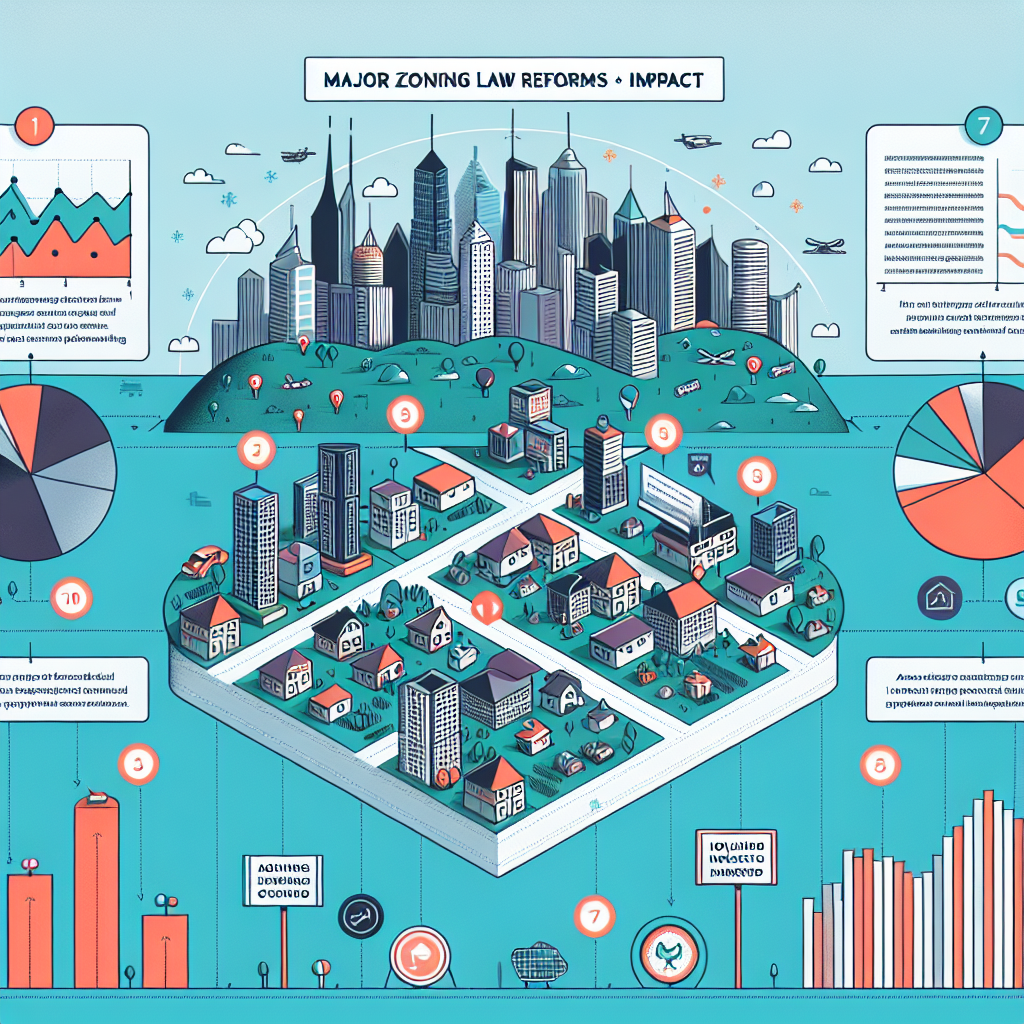-
Table of Contents
- Major Zoning Law Reforms: Crucial Insights for Investors and Housing Markets
- The Evolution of Zoning Laws
- Historical Context
- Modern Zoning Challenges
- Key Drivers of Zoning Law Reforms
- Notable Zoning Law Reforms
- Minneapolis, Minnesota
- Oregon Statewide Zoning Reform
- California’s Accessory Dwelling Unit (ADU) Legislation
- Impact on Housing Markets
- Increased Housing Supply
- Enhanced Affordability
- Economic Revitalization
- Environmental Benefits
- Case Studies: Success Stories and Lessons Learned
- Portland, Oregon: The Residential Infill Project
- Tokyo, Japan: Flexible Zoning and High-Density Development
- Challenges and Considerations
- Community Opposition
- Infrastructure and Services
- Equity and Inclusion
- Implications for Investors
- Opportunities for Development
- Market Trends
- Regulatory Compliance
- Conclusion
Major Zoning Law Reforms: Crucial Insights for Investors and Housing Markets

Zoning laws have long been a cornerstone of urban planning, dictating how land can be used and developed. These regulations impact everything from residential neighborhoods to commercial districts, and they play a crucial role in shaping the economic and social fabric of cities. In recent years, major zoning law reforms have been implemented across various regions, aiming to address issues such as housing affordability, urban sprawl, and environmental sustainability. For investors and stakeholders in the housing market, understanding these reforms is essential for making informed decisions. This article delves into the key aspects of major zoning law reforms, providing valuable insights for investors and housing markets.
The Evolution of Zoning Laws
Zoning laws have evolved significantly since their inception in the early 20th century. Initially, these laws were designed to separate incompatible land uses, such as industrial and residential areas, to protect public health and safety. Over time, zoning regulations have become more complex, incorporating various elements such as density restrictions, building heights, and land use classifications.
Historical Context
The first comprehensive zoning ordinance in the United States was enacted in New York City in 1916. This landmark legislation aimed to address issues related to overcrowding, congestion, and the negative impacts of industrial activities on residential areas. Since then, zoning laws have been adopted by municipalities across the country, each with its own unique set of regulations and objectives.
Modern Zoning Challenges
In recent decades, traditional zoning practices have faced criticism for contributing to urban sprawl, housing shortages, and socio-economic segregation. Critics argue that rigid zoning regulations often hinder the development of affordable housing and limit opportunities for mixed-use developments that can create vibrant, walkable communities.
Key Drivers of Zoning Law Reforms
Several factors have driven the push for zoning law reforms in recent years. These include:
- Housing Affordability: The rising cost of housing in many urban areas has prompted calls for zoning reforms to facilitate the development of affordable housing options.
- Environmental Sustainability: Concerns about climate change and environmental degradation have led to zoning reforms aimed at promoting sustainable land use practices.
- Economic Development: Zoning reforms can stimulate economic growth by encouraging mixed-use developments and revitalizing underutilized areas.
- Social Equity: Reforms aim to address socio-economic disparities by promoting inclusive and diverse communities.
Notable Zoning Law Reforms
Several cities and states have implemented significant zoning law reforms in recent years. Here are some notable examples:
Minneapolis, Minnesota
In 2018, Minneapolis became the first major U.S. city to eliminate single-family zoning, allowing for the construction of duplexes and triplexes in areas previously restricted to single-family homes. This reform, known as the Minneapolis 2040 Plan, aims to increase housing density and affordability while promoting more inclusive neighborhoods.
Oregon Statewide Zoning Reform
In 2019, Oregon passed House Bill 2001, which effectively ended single-family zoning in cities with populations over 10,000. The bill allows for the construction of duplexes, triplexes, and fourplexes in areas previously zoned for single-family homes. This statewide reform aims to address the housing crisis by increasing the supply of affordable housing options.
California’s Accessory Dwelling Unit (ADU) Legislation
California has enacted several laws to promote the development of Accessory Dwelling Units (ADUs), also known as granny flats or in-law units. These laws streamline the approval process for ADUs and reduce regulatory barriers, making it easier for homeowners to add additional housing units on their properties. This reform aims to increase housing supply and provide more affordable housing options in high-demand areas.
Impact on Housing Markets
Zoning law reforms can have a profound impact on housing markets. Here are some key ways in which these reforms influence the market:
Increased Housing Supply
By allowing for higher-density developments and reducing regulatory barriers, zoning reforms can increase the supply of housing units. This can help alleviate housing shortages and reduce upward pressure on housing prices.
Enhanced Affordability
Zoning reforms that promote the development of affordable housing options, such as ADUs and multi-family units, can help address the affordability crisis in many urban areas. Increased housing supply can also lead to more competitive pricing, making housing more accessible to a broader range of income levels.
Economic Revitalization
Zoning reforms that encourage mixed-use developments and the revitalization of underutilized areas can stimulate economic growth. These developments can attract businesses, create jobs, and enhance the overall vibrancy of communities.
Environmental Benefits
Zoning reforms that promote sustainable land use practices, such as higher-density developments and transit-oriented developments, can reduce urban sprawl and lower greenhouse gas emissions. These reforms can also encourage the preservation of green spaces and natural habitats.
Case Studies: Success Stories and Lessons Learned
Examining case studies of successful zoning law reforms can provide valuable insights for investors and policymakers. Here are two notable examples:
Portland, Oregon: The Residential Infill Project
In 2020, Portland implemented the Residential Infill Project (RIP), which allows for the construction of up to four housing units on residential lots previously zoned for single-family homes. The project also includes provisions for affordable housing incentives and anti-displacement measures.
Key Outcomes:
- Increased Housing Diversity: The RIP has led to the development of a wider range of housing options, including duplexes, triplexes, and fourplexes.
- Affordability Improvements: The project has contributed to increased housing affordability by expanding the supply of housing units.
- Community Support: The inclusion of anti-displacement measures has helped garner community support for the project.
Tokyo, Japan: Flexible Zoning and High-Density Development
Tokyo is often cited as a model for flexible zoning and high-density development. The city’s zoning regulations allow for a mix of residential, commercial, and industrial uses within the same area, promoting efficient land use and vibrant neighborhoods.
Key Outcomes:
- High Housing Supply: Tokyo’s flexible zoning has enabled the city to maintain a high housing supply, keeping housing prices relatively stable despite high demand.
- Efficient Land Use: The mix of land uses has created dynamic neighborhoods with easy access to amenities and public transportation.
- Economic Vitality: The city’s approach has contributed to economic growth and innovation, attracting businesses and talent from around the world.
Challenges and Considerations
While zoning law reforms offer numerous benefits, they also present challenges and considerations that must be addressed:
Community Opposition
Zoning reforms can face opposition from community members who are concerned about changes to neighborhood character, increased density, and potential impacts on property values. Engaging with the community and addressing their concerns is crucial for the successful implementation of reforms.
Infrastructure and Services
Increased housing density can strain existing infrastructure and services, such as transportation, schools, and utilities. Policymakers must ensure that infrastructure and services are adequately planned and funded to support higher-density developments.
Equity and Inclusion
Zoning reforms must be designed with equity and inclusion in mind to avoid exacerbating socio-economic disparities. This includes implementing anti-displacement measures and ensuring that affordable housing options are accessible to all residents.
Implications for Investors
For investors, understanding the implications of zoning law reforms is essential for making informed decisions. Here are some key considerations:
Opportunities for Development
Zoning reforms can create new opportunities for real estate development, particularly in areas where higher-density developments are now permitted. Investors can capitalize on these opportunities by identifying properties with potential for redevelopment.
Market Trends
Investors should stay informed about market trends and demand for different types of housing. Zoning reforms that promote affordable housing and mixed-use developments can influence market dynamics and create new investment opportunities.
Regulatory Compliance
Understanding the specifics of zoning regulations and ensuring compliance is crucial for successful real estate investments. Investors should work closely with local authorities and planning departments to navigate the regulatory landscape.
Conclusion
Major zoning law reforms are reshaping the landscape of urban development, offering new opportunities and challenges for investors and housing markets. By increasing housing supply, enhancing affordability, promoting economic revitalization, and supporting environmental sustainability, these reforms have the potential to create more vibrant, inclusive, and resilient communities. However, successful implementation requires careful planning, community engagement, and a focus on equity and inclusion. For investors, staying informed about zoning law reforms and their implications is essential for making strategic decisions and capitalizing on emerging opportunities in the housing market.
In summary, zoning law reforms are a critical tool for addressing contemporary urban challenges and shaping the future of cities. By understanding the drivers, impacts, and case studies of these reforms, investors and stakeholders can navigate the evolving landscape and contribute to the creation of thriving, sustainable communities.








